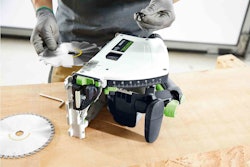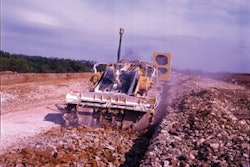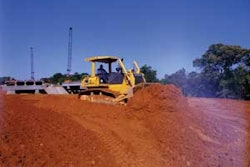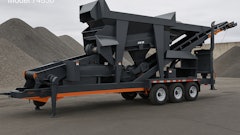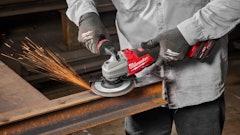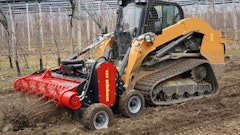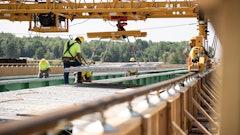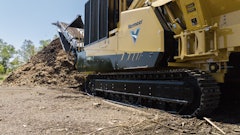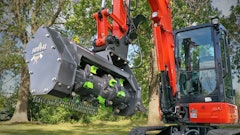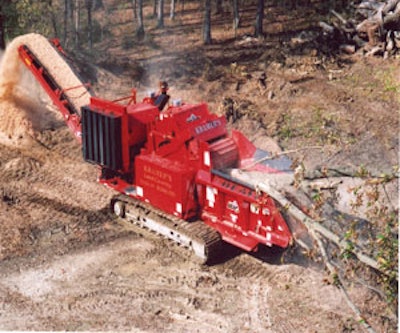
At one time, you used to be able to burn any wood waste created on a jobsite. When that was no longer acceptable, you buried it in a landfill. But today, landfill space is in short supply. Higher disposal fees and tighter restrictions make it increasingly expensive and difficult to simply haul away tree stumps, logs and branches for burial at the dump.
"The EPA and several state governments are pushing to keep all organic material out of landfills," explains Mike Byram, senior director for the environmental business segment at Vermeer."Limiting the amount of wood waste that can be buried in a landfill is one of the quickest and easiest ways for them to meet their diversion rates."
Because of the changing attitude toward wood waste, contractors are relying more heavily on wood grinders as solutions to their disposal dilemma. Some simply want to reduce the amount of bulk they take to the landfill. Others are turning lemons into lemonade by creating value-added end products such as mulch, fuel and compost.
"More and more, we're seeing that it isn't just about turning big chunks of wood into little chips to send to the landfill," says Byram. "Now contractors are trying to find ways to make something they can sell. We've seen a huge increase in the United States for colored mulch, which can sell for as much as two to two and a half times more than mulch that isn't colored. And it doesn’t cost a contractor that much to add the color."
Match to material size and shape
Whatever your intent, selecting the right grinder for the job is important. The one that’s right for you boils down to personal preference and an evaluation of the application.
Wood grinders fall into one of two categories: tub or horizontal grinders. Both contain some type of hammer mill (fixed, upswing, downswing, etc.) where all the grinding takes place. And both contain screens with grates that determine the size of the end product. But that’s where the similarities end.
"With a horizontal grinder, you feed the material horizontally from the side," he continues. "A hydraulically driven feed system turns and crushes the material and brings it into the mill. You have more control of the feeding of the material, and you can back that material out if you need to."
While each type of grinder can be used on a jobsite to reduce wood and wood products, each has its specialty. Because of its large opening, a tub grinder is most efficient at chewing away at bulky items such as tree stumps and large root balls. Material length is based on the depth of the tub, notes Byram.
"We have one grinder with a 13-ft.-diameter tub," says Brandon."You can put as big a stump as will fit in that opening."
Conversely, most horizontal grinders can only accept material up to about half that diameter. However, when it comes to grinding long lengths of material, such as trees that are 40-, 50-, even 60-ft. tall or more, a horizontal grinder will be more efficient because you won’t have to spend extra time cutting the log into shorter lengths.
"With a horizontal grinder, there are no length restrictions," says Brandon. "Once you get the butt end of the tree started through, it keeps grinding until the log is gone."
Jobsite factors to consider
A horizontal grinder is also better suited to more congested work areas, explains Bill Gehoski, regional sales manager at Bandit."Some tub grinders can throw debris 1,000 ft. or more into the air," he says."There are certain areas, such as the city of Tampa Bay, where you can’t even use a tub grinder. But a horizontal grinder can work in these areas, as well as alongside roads, etc."
It is also important to adhere to the thrown object safety zone when using a tub grinder."Don’t use a tub grinder next to a highway or in a shopping center or subdivision where you can’t control the traffic around it," says Brandon. "Instead, use a horizontal grinder because it contains the debris much better. Once the material is in the grinder, it seldom is ejected."
While a horizontal grinder may be safer from a thrown object standpoint, Byram stresses that you shouldn't become complacent in regards to safety. "A horizontal grinder has the perception of being a safer machine," he says. "I prefer to think of it in terms of the thrown object zone of a horizontal grinder being smaller than that of a tub grinder. You can take a horizontal grinder into more confined areas, but it's still important to respect the safety zone for your particular grinder."
Another difference you’ll want to consider when choosing between the grinders is how you want to load the machine. Some tub grinders are self-contained units equipped with a loader, cab and grapple. Those without self-loading capabilities have a higher load height compared to a horizontal grinder, requiring a bigger loader or maybe an excavator to load material. The lower loading height of a horizontal grinder means you can usually get away with smaller loading equipment.
Also ask yourself where you'll be taking the unit. Will the grinder sit in one spot, such as on a concrete pad, or will you be moving the machine from pile to pile or transporting it deep within the woods? If the unit is stationary, a larger trailered tub or horizontal grinder is suitable. But if you intend to frequently move the machine, you'll want a smaller, more mobile unit. Typically, a horizontal grinder is more portable than a tub grinder.
And for traversing difficult terrain, you might want to consider a unit mounted on tracks. Some tracked horizontal grinders are also self-propelled, which can minimize material handling by bringing the grinder to the material. Others are also remote-controlled, which can reduce the number of operators needed at a site.
Whichever unit you deem the best fit, Brandon stresses the importance of spending time to make the right decision."Grinders are expensive, and selecting the right one should be a decision that is not taken lightly," he says."Also, as a general rule of thumb, get one that is bigger than you think you currently need. You usually end up growing the business."
Vermeer HG6000TX
The HG6000TX horizontal grinder incorporates advanced organic waste recycling technology.
DuraTech Model 2009
The Model 2009 tub grinder is powered by a 275-hp John Deere electronic Tier II diesel engine.
Bandit Beast Recyclers
Bandit offers its Beast horizontal grinders in four sizes capable of processing a wide range of materials.
Morbark Model 1300 Tub Grinder
The Model 1300 is equipped with the Eradicator rotor.
Diamond Z DZH 5000 Series Grinder
The DZH 5000 Series horizontal grinder has production capacities of more than 100 tph.
Fecon BA Horizontal Hog
The 75,000-lb. BA Horizontal Hog has a 62-in.-wide by 42-in.-high feed opening, making it suitable for land clearing, landfill, logging and mulching operations.




